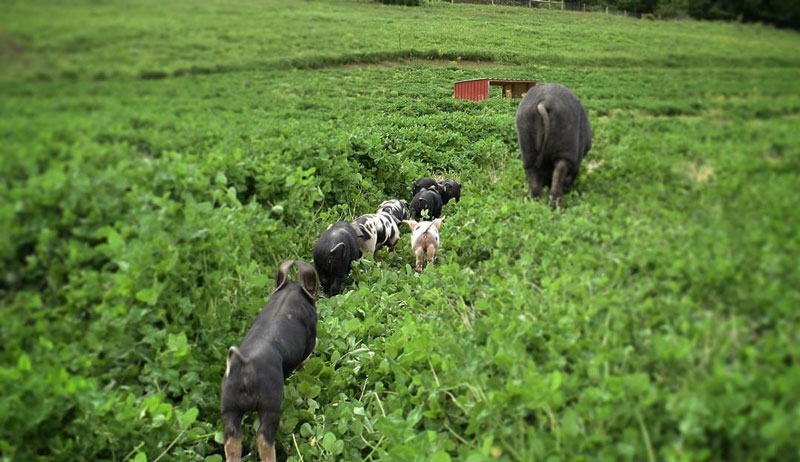
Want to feel like a bit of a lunatic? Go ask a pasture seed dealer what mix to plant for your pigs.
Although the slated concrete floors of a modern hog barn are a relatively new phenomenon in centuries of hog rearing, there’s been a lot of institutional knowledge lost on raising hogs outdoors with supplemental forage.
If you have ever found yourself consulting 1940s farm extension pamphlets for seeding guidance, flipping past pages of outdated recommendations to pour motor oil on your pigs for external pest control, you’re not alone.
Where to Start?
If this is your first season of hog forage management, things can get overwhelming very quickly. Blogs tend to devolve into a list of every plant ever produced. Consensus is lacking.
Before the panic sets in, remember that hogs are monogastric. They use pasture as a supplement, so getting a balance of pasture forages is not as nutritionally risky as it would be with a ruminant.
Also remember that any little bit helps.
Recent studies have shown that even in hogs on a full grain ration, simply incorporating pasture rotation on anything green will increase the nutrient density of pork. Producers have found access to foraging increases movement, health and swine productivity.
Pigs are already making good use of many native broadleaf “weeds” that other animals on the farm pass up. Start by observing throughout the year what native plants and areas of the pasture they eat first. You might not need to intervene much at all.
Once you’ve established that some areas need a little meddling, start small. Literally, use small seeds.
Check out these 17 pig breeds you can raise on pasture for flavorful pork.
Species Selection
Pigs are often pastured on scrubby areas that might not be suited for diesel-guzzling mechanical planting methods.
But you don’t need a seed drill and cultipacker to get great hog pastures. Vital seed-to-soil contact can be achieved as seeds land in divots from rooting leftover from fall grazing. Pigs’ nose-shaped imperfections are a perfect place for a seed to find a happy home—especially little ones.
Smaller seeds from legumes like red and white clover are the perfect starting place for beginners. Not only are they nutritionally superior, they are easy to plant. These tiny seeds will establish thrown haphazardly by the fistful or with a simple hand broadcast spreader.
Broadcasting into the hog pastures right before a late winter frost or an early spring storm will ensure the seeds get soil contact without any mechanical help. Perennial rye or orchard grasses fill out a basic starter mix for hogs that will keep them happy all growing season.
Mixing legumes and grasses are said to improve the stability of the sod and prevent loss of the either crop.
Let Them Do the Planting
Pigs can help with the big stuff also. Anyone who has ever fed a tomato to a pig and a year later discovered 30 tomato plants voluntarily established knows how well a pig can fertilize.
For larger seeds like sunflowers, buckwheat and palatable brassicas like radishes, broadcasting can work even if pigs eat the seeds and plant them in the manure. In our climate and soil type, our pigs have planted pumpkins, cucumbers, squash, tomatillos, radishes and pretty much any garden vegetable simply by eating the fruit in the fall.
With pig’s gardening skills, a surprising number of annual seed varieties can become perennial.

Deer Food Plots
If you want to take the guesswork out of seed species and selection and mixing, seek a hunter’s blend. Anything that will attract and grow a trophy buck will suit pigs well.
Though a little more pricey, many of these mixes are blended specifically for no-till, scatter-and-forget-it planting in small acreage.
In addition to possessing hilarious names like Rackmaster Extreme and Horny BuckTagged Out, whitetail food plot mixes often go on sale at times that a pig farmer may take advantage, especially as food plots for hogs can be established outside the limitations of a hunter’s calendar.
A Word of Caution
It’s difficult to get it wrong, but pig farmers raising white or pink pigs outdoors may want to consider avoiding a lot of buckwheat and varieties of rape seed, or at least include these in smaller quantities in a diverse blend. These forages have been known to increase sunburning in light skinned hogs.
Keep It Simple
A little observation goes a long way. Observe what is palatable to your animals, keep an eye on their condition and adjust your grain rations accordingly.
Over time, pigs are a very effective tool to help establish a healthy stand of both native and seeded forages.




